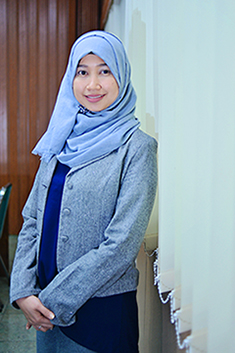The Effect of Decyl Glucoside on Stability and Irritability of Nanostructured Lipid Carriers-Green Tea Extract as Topical Preparations
Downloads
Background: Green Tea Extract (GTE) is a natural antioxidant compound that can protect the skin from photocarcinogenesis (DNA damage due to ultraviolet exposure). GTE has low stability, which needs a delivery system such as Nanostructured Lipid Carriers (NLC) with decyl glucoside (DG) as a natural surfactant that at the right concentration can produce a significantly small particle size which can improve the stability of the NLC. Objective: To determine the effect of DG usage on the characteristics, physical stability, and irritability of NLC-GTE preparation. Methods: NLC-GTE preparation used the High Shear Homogenization (HSH) method with three formulas, which contained DG 2%, 2.5%, and 3% consecutively. Afterwards, the characteristic and physical stability tests were conducted using the thermal cycling method for three cycles with two different temperatures (48 hours/cycle, 2 - 8°C and 40°C). The irritability test used Hen's Egg Test on the Chorioallantoic Membrane (HET-CAM) method. Results: Characteristic test of organoleptic showed that all formulas were white, odorless, and had a semi-solid consistency. However, the pH, particle size, and polydispersity index values from all formulas were within the normal range of values. The physical stability test result showed that 3% DG was the most stable formula. This formula was within the non-irritating range of values in HET-CAM. Conclusion: NLC-GTE with an increased concentration of DG as a surfactant can improve the characteristics and physical stability of the preparation. F3 (3% DG) is the best formula compared to other formulas and indicates non-irritating in the HET-CAM test.
A'yun, N. Q. (2019). Pengaruh Penambahan Space Peptide terhadap Tabilitas dan Efektivitas Krim Freeze Dried Amniotic Membrane Stemcell Metabolite Product (AMSC-MP). Tesis; Universitas Airlangga, Surabaya.
Avadi, M. Z., Sadeghi, A. M. M., Mohammadpour, N., Abedin, S., Atyabi, F., Dinarvand, R. & Rafiee-Tehrani, M. (2010). Preparation and Characterization of Insulin Nanoparticles Using Chitosan and Arabic Gum with Ionic Gelation Method. Nanomedicine: Nanotechnology, Biology, and Medicine; 6; 58-63. doi: 10.1016/j.nano.2009.04.007.
Averina, E. S., Seewald, G., Muller, R. H., Radnaeva, L. D. & Popov, D. V. (2009). Nanostructured Lipid Carriers (NLC) on the Basis of Siberian Pine (Pinus sibirica) Seed Oil. Pharmazie; 65; 25-31.
Chaiyana, W., Anuchapreeda, S., Somwongin, S., Marsup, P., Lee, K. H., Lin, W. C., & Lue, S. C. (2020). Dermal Delivery Enhancement of Natural Anti-Ageing Compounds from Ocimum sanctum Extract by Nanostructured Lipid Carriers. Pharmaceutics; 12; 1-12. doi: 10.3390/pharmaceutics12040309.
Chen-yu, G., Chen-yu, Y., Qi-lu, L., Qi, T., Yan-wei, X., Wei-na, L. & Guang-xi, Z. (2012). Development of a Quercetin-Loaded Nanostructured Lipid Carrier Formulation for Topical Delivery. International Journal of Pharmaceutics; 430; 292-298. doi: 10.1016/j.ijpharm.2012.03.042.
Dal Belo, S. E., Gaspar, L. R., Maia Campos, P. M. B. G. & Marty, J. -P. (2009). Skin Penetration of Epigallocatechin-3-Gallate and Quercetin from Green Tea and Ginkgo Biloba Extract Vehiculated in Cosmetic Formulations. Skin Pharmacology and Physiology; 22; 299-304. doi: 10.1159/000241299.
Faizatun, Gangga, E., Anindita, S., Martati, T. & Miftahurrohmah, N. (2020). Formulation of NLC Gel from Callus Mulberry Leaf Extract Induced by NAA and BAP). Jurnal Ilmu Kefarmasian Indonesia; 18; 123-129. doi: 10.35814/jifi.v18i1.814.
Hagino, S., Kinoshita, S., Tani, N., Nakamura, T., Ono, N., Konishi, K., Iimura, H., Kojima, H. & Ohno, Y. (1999). Interlaboratory Validation of In Vitro Eye Irritation Test for Cosmetic Ingredients. (2) Chorioallantoic Membrane (CAM) Test. Toxicology in Vitro; 13; 99-113. doi: 10.1016/s0887-2333(98)00065-4.
Han, F., Li, S., Yin, R., Liu, H., & Xu, L. (2008). Effect of Surfactant on the Formation and Characterization of a New Type of Colloidal Drug Delivery System: Nanostructured Lipid Carriers. Colloids and Surfaces A: Physicochem. Eng. Aspect; 315; 210-216. doi: 10.1016/j.colsurfa.2007.08.005.
Indrajaya, S. (2021). Pengaruh Carbopol940 dan CMC-Na terhadap Karakteristik, Stabilitas Fisik, Efektivitas dan Iritabilitas Ubiquinone – Nanostructured Lipid Carriers (NLC) dalam Hydrogel Sleeping Mask sebagai Kosmetik Antiaging. Tesis; Universitas Airlangga, Surabaya.
Katiyar, S., Elmest, C. A. & Katiyar, S. K. (2009). Green Tea and Skin Cancer: Immunological Modulation and DNA Repair. In: Aaron Tabor & Robert Blair (ed.) Nutritional Cosmetics Beauty from Within; 472-491. Oxford, USA: William Andrew.
Kosswig, K. (2012). Surfactants. In Ullmanns (ed.) Encyclopedia of Industrial Chemistry; 35; 431-505.
Lasoń, E., Sikora, E., Miastkowska, M., Escriano, E., Garcia-Celma, M. J., Solans, C., Llinas, M. & Ogonowski, J. (2018). NLCs as a Potential Carrier System for Transdermal Delivery Forskolin. Acta Biochimika Polonica; 65; 437-442. doi: 10.18388/abp.2018_2554.
Loreta, L. J. (2015). Pengaruh Tween 80 sebagai Emulsifying Agent dan Sorbitol sebagai Humektan dalam Sediaan Krim Ekstrak Daun Jambu Biji (Psidium guajava L.) dengan Aplikasi Desain Faktorial. Skripsi; Universitas Sanata Dharma, Yogyakarta.
Lullung, A. & Suprapti. (2012). Effect of Surfactant on Particle Diameter, Viscosity and the Polydispersity Index of SLN Making Cocoa Fat. Jurnal RisetTeknologi Industri; 6; 1-10. doi: 10.26578/jrti.v6i12.1512.
Manea, A. M., Vasile, B. S. & Meghea, A. (2014). Antioxidant and Antimicrobial Activities of Green Tea Extract Loaded Into Nanostructured Lipid Carriers. Comptes Rendus Chimie; 17; 331-341. doi: 10.1016/j.crci.2013.07.015.
Mayangsari, F. D. (2021). Efek Minyak Nilam, Pepermin dan Rosmeri pada Karakteristik Fisik, Stabilitas Fisik, Iritabilitas, dan Efektivitas NLC Coenzyme G10 Sleeping Mask sebagai Kosmetik Antiaging. Tesis; Universitas Airlangga, Surabaya.
Mehling, A., Kleber, M. & Hensen, H. (2007). Comparative Studies on the Ocular and Dermal Irritation Potential of Surfactants. Food and Chemical Toxicology; 45; 747-758. doi: 10.1016/j.fct.2006.10.024.
Müller-Fischer, N., Suppiger, S. & Windhab, E. J. (2007). Impact of Static Pressure and Volumetric Energy Input on the Microstructure of Food Foam Whipped in a Rotor-Stator Device. Journal of Food Engineering; 80; 306-316. doi: 10.1016/j.jfoodeng.2006.05.026.
Oliveira, R. N. d., Campos, P. M., Pinto, R. M. C., Mioduski, J., Santos, R. D., Justus, B., Paula, J. d. F. P. d., Klein, T., Boscardin, P. M. D., Corríªa, S. d. A. P., Allegretti, S. M. & Ferrari, P. C. (2021) The Promising Antischistosomal Activity of Oleic Acid-Loaded Polymeric Nanocapsules for Oral Administration. Journal of Drug Delivery Science and Technology; 63; 1-9. doi: 10.1016/j.jddst.2021.102429.
Rohmah, N. N. (2020). Pengaruh Peppermint Essential Oil terhadap Karakteristik dan Stabilitas Fisik (Thermal Cycle) Sistem Nanostructured Lipid Carriers Coenzyme Q10. Skripsi; Universitas Airlangga, Surabaya.
Saini, S., Gupta, A., Singh, N. & Sheikh, J. (2019). Functionalization of Linen Fabric Using Layer by Layer Treatment with Chitosan and Green Tea Extract. Journal of Industrial and Engineering Chemistry; 4811; 1-6. doi: 10.1016/j.jiec.2019.10.005.
Sharma, A. & Baldi, A. (2018). Nanostructured Lipid Carriers: A Review. Journal of Developing Drugs; 7; 1-12. doi: 10.4172/2329-6631.1000191.
Shi, M., Shi, Y. L., Li, X. M., Yang, R., Cai, Z. Y., Li, Q. S., Ma, S. C., Ye, J. H., Lu, J. L., Liang, Y. R. & Zheng, X. Q. (2018). Food-Grade Encapsulation Systems for (-)-Epigallocatechin Gallate. Molecules; 23; 1-17. doi: 10.3390/molecules23020445.
Siyahpoosh, A., Sheikhi, A. R., Jafarzadeh, E. & Pipelzadeh, M. (2022). Effectiveness of Green Tea Cream in Comparison with Silver Sulfadiazine Cream in Treatment of Second Degree Burn in Human Subject. Journal of Herbal Medicine; 32; 1-8. doi: 10.1016/j.hermed.2022.100533.
Souto, E. B. & Muller, R. H. (2008). Cosmetic Features and Application of Lipid Nanoparticles (SLN, NLC). International Journal of Cosmetic Science; 30; 157-165. doi: 10.1111/j.1468-2494.2008.00433.x.
Souto, E. B., Baldim, L., Oliveira, W. P., Rao, R., Yadav, N., Francisco M. G. & Sheefali, M. (2020). SLN and NLC for Topical, Dermal, and Transdermal Drug Delivery. Expert Opinion on Drug Delivery; 1-12. doi: 10.1080/17425247.2020.1727883.
Subramaniam, B., Siddik, Z. H. & Nagoor, N. H. (2020). Optimization of Nanostructured Lipid Carriers: Understanding the Type, Design and Parameters in the Process of Formulation. Journal of Nanoparticle Research; 22(141); 1-29. doi: 10.1007/s11051-020-04848-0.
Sugihartini, N., Susanti, H., Zaenab, Hanifah, H. & Marlina, S. A. (2016). Stabilitas Epigalokatekin Galat dalam Krim The Hijau dengan Variasi konsentrasi Antioksidan Vitamin C 1% dan Vitamin E 1%. Jurnal Farmasi Sains dan Komunitas; 13; 52-56. doi: 10.24071/jpsc.132186.
Tamjidi, F., Shahedi, M., Varshosaz, J. & Nasirpour, A. (2013). Nanostructured Lipid Carriers (NLC): A Potential Delivery System for Bioactive Food Molecules. Innovative Food Science and Emerging Technology; 19; 29-43. doi: 10.1016/j.ifset.2013.03.002.
Wang, T., Zhang, F., Zhao, R., Wang, C., Hu, K., Sun, Y., Politis, C., Shavandi, A. & Nie, L. (2020). Polyvinyl Alcohol/Sodium Alginate Hydrogels Incorporated with Silver Nanoclusters via Green Tea Extract for Antibacterial Applications. Designed Monomers and Polymers; 23(1); 188-133. doi: 10.1080/15685551.2020.1804183.
Widowati, W., Herlina, T., Ratnawati, H., Constantia, G., Deva, I. D. G. S. & Maesaroh, M. (2015). Antioxidant Potential of Black, Green and Oolong Tea Methanol Extracts. Biology, Medicine, & Natural Product Chemistry; 4; 35-39. doi: 10.14421/biomedich.2015.42.35-39.
Witayaudom, P. & Klinkesorn, U. (2017). Effect of Surfactant Concentration and Solidification Temperature on the Characteristics and Stability of Nanostructured Lipid Carrier (NLC) Prepared from Rambutan (Nephelium lappaceum L.) Kernel Fat. Journal of Colloid and Interface Science; 505; 1082-1092. doi: 10.1016/j.jcis.2017.07.008.
Yuliani, S. H., Rahmadani, Y. & Istyastono, E. P. (2016). Irritation Test of Wound Healing Gel of Ethanolic Extract of Binahong Leaf Using Slug Irritation Test. Jurnal Ilmu Kefarmasian Indonesia; 14; 135-140.
Zirak, M. B. & Pezeshki, A. (2015). Effect of Surfactant Concentration on the Particle Size, Stability and Potential Zeta of Beta Carotene Nano Lipid Carrier. International Journal of Current Microbiology and Applied Sciences; 4(9); 924-932.
Copyright (c) 2022 JURNAL FARMASI DAN ILMU KEFARMASIAN INDONESIA

This work is licensed under a Creative Commons Attribution-NonCommercial-ShareAlike 4.0 International License.
1. The copyright of this journal belongs to the Editorial Board and Journal Manager with the author's knowledge, while the moral right of the publication belong to the author.
2. The formal legal aspect of journal publication accessibility refers to the Creative Commons Attribution-Non-Commercial-Share Alike (CC BY-NC-SA), which implies that the publication can be used for non-commercial purposes in its original form.
3. Every publication (print/electronic) is open access for educational, research, and library purposes. In addition to the objectives mentioned above, the editorial board is not responsible for copyright infringement


.jpg)















